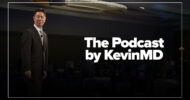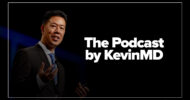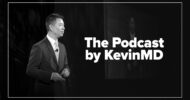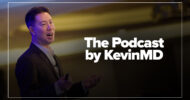Subscribe to The Podcast by KevinMD. Watch on YouTube. Catch up on old episodes!
Osteopathic medical student Scarlett Saitta discusses her article “The school cafeteria could save American medicine.” Scarlett discusses the profound connection between childhood nutrition and long-term health outcomes, drawing from her personal experiences and observations in her hometown. She highlights how current food systems contribute to chronic illnesses like type 2 diabetes and hypertension, and how misleading food marketing exacerbates the problem. Scarlett shares her proposed solution: The American Farm and School Nutrition Support Act, a federal policy amendment aiming to expand Farm-to-School programs by reallocating existing funds to support whole, locally sourced foods in schools. She emphasizes that this initiative not only improves child health but also supports rural economies and addresses health disparities. Scarlett explains the political process of advocating for such a bill, stressing the importance of listening and building bridges across political divides. She also shares data supporting the efficacy of improved school nutrition standards and discusses how this work is a part of the future of medicine, focusing on holistic well-being beyond clinical settings.
Our presenting sponsor is Microsoft Dragon Copilot.
Microsoft Dragon Copilot, your AI assistant for clinical workflow, is transforming how clinicians work. Now you can streamline and customize documentation, surface information right at the point of care, and automate tasks with just a click.
Part of Microsoft Cloud for Healthcare, Dragon Copilot offers an extensible AI workspace and a single, integrated platform to help unlock new levels of efficiency. Plus, it’s backed by a proven track record and decades of clinical expertise—and it’s built on a foundation of trust.
It’s time to ease your administrative burdens and stay focused on what matters most with Dragon Copilot, your AI assistant for clinical workflow.
VISIT SPONSOR → https://aka.ms/kevinmd
SUBSCRIBE TO THE PODCAST → https://www.kevinmd.com/podcast
RECOMMENDED BY KEVINMD → https://www.kevinmd.com/recommended
Transcript
Kevin Pho: Hi, and welcome to the show. Subscribe at KevinMD.com/podcast. Today we welcome Scarlett Saitta. She’s an osteopathic medical student. Today’s KevinMD article is “The school cafeteria could save American medicine.” Scarlett, welcome to the show.
Scarlett Saitta: It is a pleasure to be here. Thank you so much for inviting me.
Kevin Pho: So the article came from a mix of personal experience and the process of realizing just how complex real-world change can be. I’m from a small Appalachia community where, sadly, chronic illness and food insecurity are just a part of everyday realities.
The environment really shaped my desire to build those nutritional habits from childhood in underserved communities. So I drafted the American Farm to School Nutrition Act, which was a federal proposal. I thought to myself, how come we can’t just reallocate existing USDA funds to get healthier and locally sourced food into schools?
But the more I learned, such as from mentors from my school who have been doing policy for years, I realized the policy isn’t just as simple as having a good idea. It’s going to require a lot of collaboration with people who have been working on this for decades, such as advocacy and specialty groups. Which is why the article isn’t just about the proposal, but a bit of a mindset shift. And the mindset shift has also developed a lot more since I wrote the article. Since I wrote the article, instead of thinking, what do I want to push, I more so thought of, how do I learn from this?
It could take literal years to learn about even one segment of a specialty in advocacy since it’s not really as simple as what the news makes it sound like. So now I’m meeting with farmers, food banks, and school nutrition leaders so I can learn more deeply about the roadblocks in this field.
Kevin Pho: All right, so, tell us about your background. In your article, you start with an anecdote about growing up in South Carolina and witnessing food insecurity firsthand. So tell me, how did your early personal experiences inform and lead you to write the article and propose the act?
Scarlett Saitta: So I myself was fortunate enough to not grow up in a food-insecure household, but I did know a lot of friends who did. I had friends who, during the week, ate two-thirds of their meals at school. I also had some who sadly didn’t have any food on the weekends. But how it led me to the article is a lot of the food that was served in the cafeteria, it was a really good thing that at least food was served, but it wasn’t the most healthy.
I did later dive into, and also noticed since I started working as a wellness coach later on, that people who really fortified and trained their taste to healthier whole foods were a lot more likely to carry those habits on into adulthood. I also saw how the lack of knowledge of what healthy food is, a lot of big food companies tended to prey on that. For example, they would have macaroni and cheese that said something like low or no sugar, but it would be very packed with fat and very processed material that would spike your blood sugar.
I thought of this proposal so students could further fortify those habits and train their taste to these whole foods in childhood and carry those habits throughout life. And a lot of research shows that children who eat healthy as children, they end up carrying those habits throughout life. So that’s what pushed me to write the article and rewrite the proposal.
Kevin Pho: So just paint a picture; give us an example. As you were growing up, you mentioned that some of your peers would eat two-thirds of their meals at school, but it wouldn’t always be the healthiest option. So just give us an example of what was offered to them.
Scarlett Saitta: I do remember it was a lot of chips, a lot of fried chicken, for example, Tyson. A lot of white bread, peanut butter and jellies, but the jelly would typically be very loaded with sugar. A lot of white material that would spike your blood sugar. So in the chicken pot pie, for example, it would also taste very, extremely salty. And I later learned that this is because a lot of federal bills for school lunches end up going to big companies such as Tyson and Lay’s in order to make the school lunches look more like this. So in summary, that is what I would say an average school lunch tended to look like from what I recall.
Kevin Pho: You also mentioned that a lot of the labeling can be misleading, and you also told a story in your article about your friend’s mother being misled by some of these food labels. Go into a little bit more detail in terms of how this food marketing can eventually lead to widespread consumption of these ultra-processed foods. And obviously, that’s not going to lead to healthy outcomes as well.
Scarlett Saitta: To go into a little bit more depth with that, there are also several articles published by, I think it’s the Harvard School of Public Health, on this topic exactly. But a lot of food companies, especially recently… So for example, I was walking through the store the other day and there was this lemonade mix, and it said high in vitamin C. I turned it around and it said per serving, it was something about 30 or 36 grams of added sugar, which I believe on an average day, an adult female is not supposed to exceed 25 grams of added sugar. But I looked at the vitamin C section and it said 10 percent.
Well, I’m not sure what the average person would think “rich in vitamin C” means, but 10 percent seems very low. Harvard has also published several articles on this saying there’s not a lot of legal requirements for what meets “high in vitamin C” or “low in sugar.” So I believe that also tends to mislead people a lot.
Kevin Pho: So you proposed the American Farm and School Nutrition Support Act. Tell us a little bit more about what that entails.
Scarlett Saitta: I’ve definitely stepped a little bit away from proposing an act directly because this process is a lot more complicated than what I originally thought it was going to be. I never had a formal class on policy, but I ended up doing some research, especially over spring break, and I thought back to those lunch trays and I was like, where is the money for, for example, the National School Lunch Program? What companies is it exactly going to? And I thought, what if that could be reallocated to local farmers?
So I drafted that proposal out since I’ve kind of been tapping into this issue for years, using a lot of peer-reviewed research. But I’ve shifted a little bit from that, and I’m currently reaching out to people who have had their boots on the ground in this field for years. So for example, there’s the Arkansas Food Bank that has employees that go to Washington, D.C., to lobby for SNAP. I’ve met with some people who’ve said this can maybe be woven into something for SNAP or GusNIP.
Kevin Pho: Are you familiar with what GusNIP is? For those listeners who aren’t, just tell us what SNAP and GusNIP are.
Scarlett Saitta: So, SNAP is basically food stamps. It varies on the degree in which people use them, but it’s where you get these tickets for discounted or free food. GusNIP is basically where you get these tickets for discounted, healthy, locally purchased food.
I’ve heard that this could potentially be woven into that, but there are a lot of nuances and things that I just wasn’t aware of. There are people who spend years in a little tiny part of any type of advocacy field, and they’ll dig and dig for years. They’re asked, why did this good idea not work? Because there’s a lot going on under the hood that a lot of people, including myself, don’t realize. So it’s really important to ask the questions of, why did this work? Why did this not work?
A lot of laws that are actually passed, if you look on bill-trackers, they’ll amend these tiny little parts of these laws and acts. The act will be something like 2,000 pages and they’ll amend just that one thing. And that’s most of the time where progress kind of goes and where it begins, as opposed to a big, sweeping change.
Kevin Pho: So, tell us about some of the paths forward. In terms of what you would like to see done after talking to some of the advocates in this area, what are some actionable steps forward that you’d like to see happen?
Scarlett Saitta: I’m very much in the learning stage of this, so I am meeting with some people who work for the SEEDS program in Vermont, which is a farm-to-school program, which basically facilitates the purchasing of local, typically healthier foods from local farmers, and they make it onto the lunch tray.
Realistically, what could happen is I may have to go to a more local level. For example, even working with one school in Arkansas about maybe having a gardening program. The kids grow the vegetables and they end up on the school lunch tray, since there is a wealth of evidence to suggest that children who grow certain types of crops that end up on the lunch tray end up consuming more vegetables and fruits at school and at home. So, change could be extremely local, but I guess getting any type of progress on the federal level is considered to be a massive, massive stretch. And it’s also a little bit of luck, too, so it could depend on what legislative vehicles happen to be going through at the time. But I am trying to reach out to Feeding America and I think the U.S. Farm Bureau as well about this to see where it can go and anything they’re currently working on or it could potentially be attached to.
Kevin Pho: So you are a first-year medical student, so you’re just starting your medical journey. As a future physician, tell us about some of the ways that you think you could influence food policy. Do you have any ideas during the start of your medical education journey where you can influence this issue from that perspective?
Scarlett Saitta: Patient stories and patient observation definitely go a very long way, as does having an open mind, because sometimes the research and what you see with your own eyes… neither are wrong, but one may not be covered in the other field. Really learning from that and also seeing the way that my patients could potentially understand the idea of “healthy.” And the same with me, too, since eating healthy and maintaining a healthy lifestyle is a lifelong journey, not just something you can learn in one afternoon. Probably weaving that into the policy, too.
Another thing, too, as I’ve learned in this field is that personal stories from people you know, you’ve treated, from people who have passed away, those could also be extremely powerful in this field. Having a story in politics definitely can take you a very long way.
As far as on the personal level, I’m an aspiring psychiatrist, but I view it through the osteopathic lens, which is that mind, body, and spirit are forever connected, and if one is off, the others could also be influenced as well. So, and there’s also a growing amount of research to suggest that people who have healthy diets tend to have better mental health. So also working with my patients. For example, if they can’t afford the more traditional healthy options because a lot of stores have marketing campaigns where they’ll put, for example, chopped watermelon in pretty little plastic bowls and covers in the front of the store because it’s the first thing that you tend to see, hoping that you’ll buy it. So they’ll raise the price up, but it won’t be as cheap as, for example, the bag of black beans that are on the bottom shelf in the back corner of the store. So even just little things like that can really make a difference within somebody’s life.
But also to approach it from a non-judgmental perspective and realize that no type of sense is really common. In summary, that’s probably what I would do.
Kevin Pho: Do you have any nutritional education in medical school? I hear a lot of times that that is one of the areas that is lacking in medical education: basic nutritional knowledge or how to advocate for nutrition or teaching physicians in general more about better nutrition. Have you experienced anything like that?
Scarlett Saitta: My school does a very good job at teaching how to read a food label correctly and how to not, or a better job than most schools on how to not be thrown off by those advertising labels that could be technically true, but there’s a bunch of other bad things that override the good in the background. People I’ve spoken to at other schools seem to not get this level of nutritional education, but I’ve only spoken to people from four other schools. I’ll have to admit, I haven’t read a lot of the research on it, so I’m not sure what it’s like at other schools. But I will say a lot of the nutritional stuff that I know, I taught myself.
For example, how much saturated fat, how long the list of chemicals should roughly be, and a general rule that my mother taught me, since she’s always been into nutrition and working out. I also worked as a wellness coach, which is a step down from a personal trainer. The quote that my mom always told me is, unless it has a lot of animal fat in it, stick to what God made. In general, the outskirts of the store. So typically, the closer the food is to its natural state, typically the more healthy it’s going to be.
Kevin Pho: Now, what about those other medical students or physicians who want to be involved from a policy aspect when it comes to addressing food insecurity? You’ve been involved in this field, so what kind of tips do you have for them?
Scarlett Saitta: A lot of times, getting involved can look very small, but it has a massive impact behind the scenes that you may not see. For example, you can volunteer at a food pantry. I did that in two separate states during COVID. That definitely taught me a lot.
It could also just be as simple as reaching out to the principal of a certain school. You could say, “I have this idea for a garden that they could grow sweet peas in, for example, and that could end up on the lunch tray. Would you guys be open to exploring that idea more?” You can also find a lot of articles online of people who have done the same thing, especially if it’s from a .org or a more credible website.
It could start as that. It could also be them educating their patients on how to eat healthier in a way that’s very comprehensible to them. So, teaching people to advocate for themselves. They could also pass it along to their families or anyone that they happen to know.
A lot of times change starts on a very seemingly small level. There’s a lot of impact it could have that you’ll just never see.
Kevin Pho: Scarlett Saitta is an osteopathic medical student. Today’s KevinMD article is “The school cafeteria could save American medicine.” Scarlett, let’s end with some take-home messages you want to leave with the KevinMD audience.
Scarlett Saitta: The only take-home message I can think of off the top of my head now is basically a lot of things that I’ve already said. You may not think that you’re making a sweeping change, but a big change could even be something like a student choosing an apple over applesauce just to avoid a lot more added sugar. Because from a humbling perspective, you taught them to eat the closest form that it was to on the branch, on the bush, or in the ground. And them making those decisions repeatedly throughout their life ends up giving them better mental health and better longevity. So that was probably a big take-home message from that.
Kevin Pho: Got it. Thank you so much for sharing your perspective and insight. And thanks again for coming on the show.
Scarlett Saitta: Thank you so much, Dr. Pho.

























